This Dutch Oven Sourdough Sweet Potato Crunch Bread is ideal for Fall and Holiday dinner tables. It has the traditional ingredients found in Sweet Potato Crunch, a favorite Holiday dish, but also features flavors and textures you’ll only experience in the bread form. It has become one of my “goto” breads.
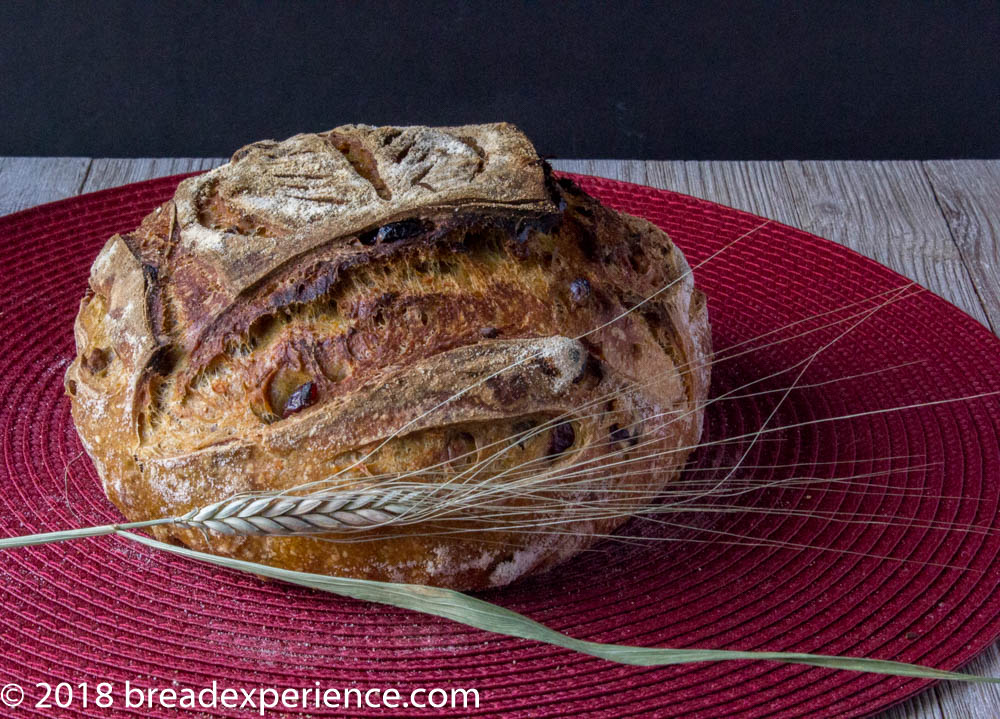
Sourdough Sweet Potato Crunch Bread with Emmer, Spelt, Pecans & dried Cranberries
This bread tastes as the name suggests. It’s chewy on the outside and full of flavor on the inside.
It utilizes an overnight sourdough pate fermentee, a method I’ve been experimenting with for several weeks. The pate fermentee, which is similar to the consistency of dough, provides flavor and strength to the final dough. This type of preferment typically includes a pinch of yeast, and then more yeast is added to the final dough. However, with the method I’ve been using recently, you add 25 grams of sourdough in the overnight preferment, and it provides the lift to the final dough without needing any extra yeast.
I’ve made this bread several times to make sure I had the process down. The first time I made it, it was missing something. So I tweaked it a bit and brought the updated version to a dinner party without even testing the finished product. I did try the dough, just not the baked loaf.
The ladies in my dinner group were very gracious, and I think pleasantly surprised. “This bread is awesome!” was the most common exclamation, and “Bring this bread next month!” was another comment. It always makes me smile when the bread ideas swirling around in my head come to life, and people enjoy eating the results.
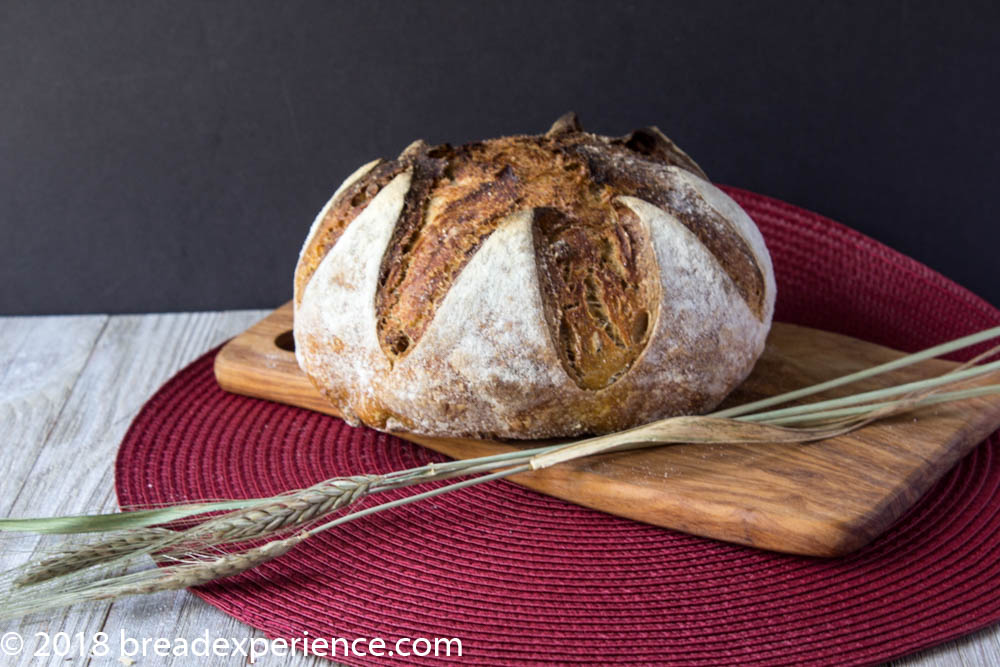
Sourdough Sweet Potato Crunch Bread with Emmer, Spelt & Pecans
I’ve made different versions of this bread, using different flour combinations based on the type of wholegrain flour I had on hand. The emmer and rye version made its debut at the ladies’ dinner group several weeks ago, and the emmer and spelt version (pictured below) was the star of my family’s Thanksgiving dinner.
I like both versions equally well.
Here is the Thanksgiving bread pictured with some of the test emmer wheat I grew in my yard. Although I didn’t grow enough wheat for bread (because I was testing it to see if it would even grow in Georgia), the einkorn and emmer wheat stalks I used as centerpieces on my Thanksgiving tables made nice conversation pieces.
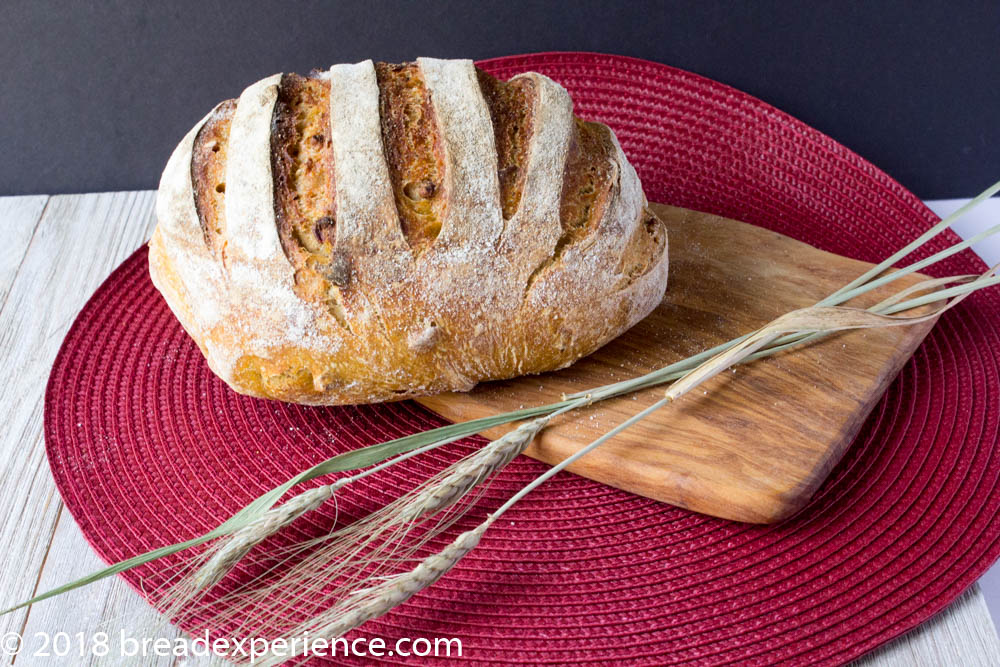
Make this Sourdough Sweet Potato Crunch Bread using a sourdough starter or yeast
Sourdough Method:
I used my favorite starter for this bread.
Yeast Method:
If you don’t have a sourdough starter, you can make this bread using yeast. Add a pinch of instant dry yeast to the Pate Fermentee and follow the same process for the fermentation. Then add 1 1/4 teaspoons of yeast to the final dough and follow the rest of the process.
What type of sweet potato should you use? updated Jan 2019
I used orange sweet potatoes in this loaf. They paired well with the pecans, dried cranberries, and brown sugar. Everyone enjoyed this bread so much, I don’t think I would change the type of potatoes I use for this particular loaf.
However, I used purple sweet potatoes for the Sourdough Sweet Potato Onion Loaf we made during the monthly challenge for the Bread Baking Babes. I loved the flavor and texture of that loaf. Purple sweet potatoes have a chestnut flavor and make the dough nice and fluffy.
How should you roast the sweet potato? updated Jan 2019
The method I used to roast the sweet potatoes for this loaf, was to cut the sweet potato up into chunks, drizzle olive oil over the chunks, and then roast them. That method works fine, but I have since learned a different method of roasting sweet potatoes that you might enjoy.
Cut off the ends of the potato, roast it whole (with the skin on) at 400F for about 45 minutes, then scoop out the flesh. It works like a charm! I added these instructions in the notes of the printable recipe below.
Refer to this Sourdough Sweet Potato Onion Loaf post to see the bread I made using the new roasting method, along with a photo of the roasted potato with the skin just peeling off.
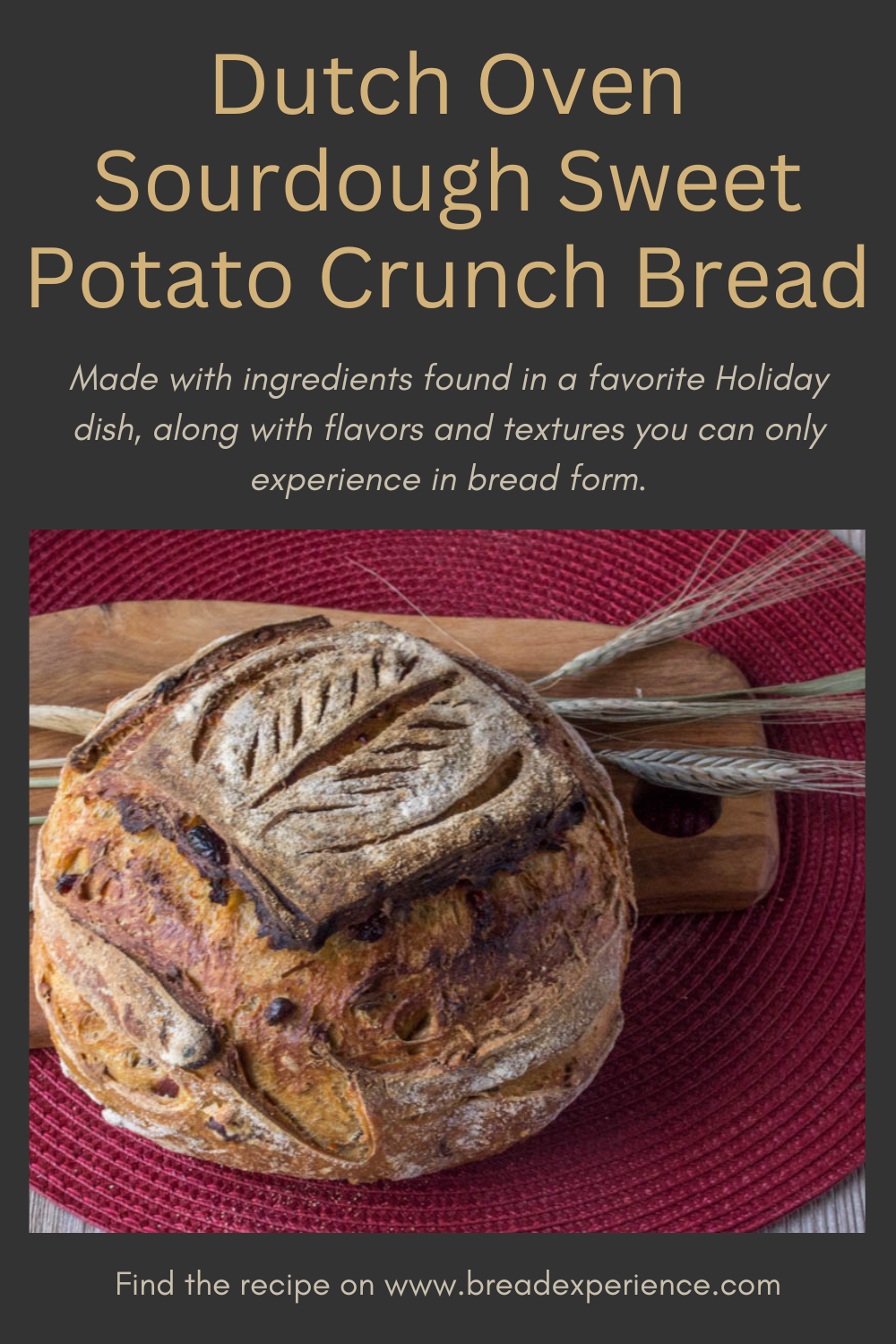
Dec 2022 – slightly edited ingredients and instructions.
This sourdough sweet potato crunch bread is one of my favorite loaves to take to Holiday luncheons or dinners. It always gets rave reviews. It has a complex, yet pleasing flavor due to the whole grains.
Make Bread Pudding with this Sweet Potato Bread
If you have leftover slices of this bread, don’t let them go to waste, cut them into bread cubes and make this rich and comforting bread pudding. Use day-old or slightly stale bread for optimal results.
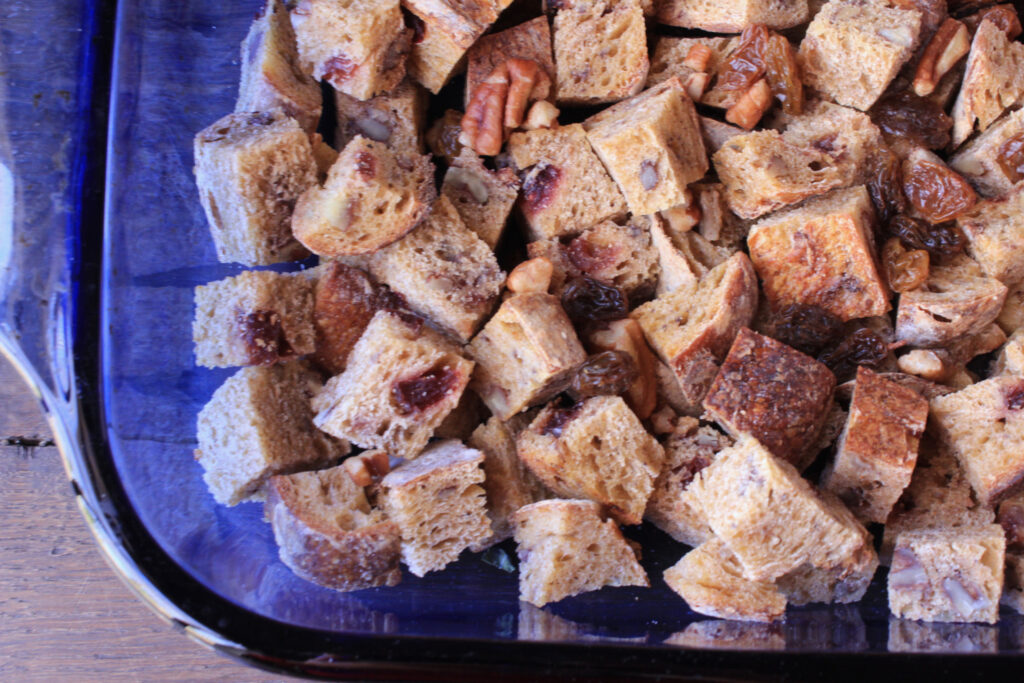
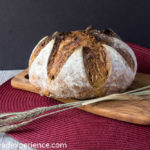
Dutch Oven Sourdough Sweet Potato Crunch Bread
- Yield: 2 Loaves 1x
Description
This Dutch Oven Sourdough Sweet Potato Crunch Bread is ideal for Fall and Holiday dinner tables. It has the traditional ingredients found in Sweet Potato Crunch, a favorite Holiday dish, but also features flavors and textures you’ll only experience in the bread form.
Ingredients
Pate Fermentee:
- 272 grams (2 1/8 cups) all purpose flour
- 180 grams (3/4 cup) water
- 5 grams (1 tsp) salt
- 25 grams sourdough starter (See notes)
Final Dough:
- 450 grams (3 1/2 cups) all-purpose flour
- 75 grams (~1/2 cup) whole grain flour (ex. emmer, spelt, rye)
- 136 grams (1 1/8 cups) different type whole grain flour (rye, spelt, or other)
- 325 – 400 grams (1 3/8 – 1 3/4 cups) water
- 30 grams (3 Tbsp.) brown sugar, packed
- 225–250 grams roasted sweet potatoes
- 1/2 tsp cinnamon
- 15 grams (3 tsp) salt
- 85 grams (3/4 cup) chopped pecans
- 90 grams (3/4 cup) dried cranberries, optional
- Pate fermentee, all of the above
Instructions
Day 1 – Prepare the Pate Fermentee
- The day (or evening) before you plan to make the bread, add all of the pate fermentee ingredients in a medium bowl and mix using a wooden spoon or Danish dough whisk until just smooth.
- Cover tightly with plastic wrap or a tight-fitting lid. Allow the preferment to sit at room temperature for 12-16 hours, depending on temperature in your kitchen.
- After the pate fermentee has fermented on the counter, use it immediately in the final dough or place it in the refrigerator for a day or two before using. If you place it in the refrigerator, allow it to warm up to room temperature before adding to the dough.
Roast the sweet potato
- Refer to the notes for the roasting method. You may prepare the sweet potato ahead of time and place in the refrigerator or make it the same day as the final dough. Cool slightly then mash with a potato masher. Use 200-250 grams of the potato mash in the final dough.
Day 2 – Mix the Final Dough
- This dough can be mixed by hand, but it’s a workout! I recommend using a stand mixer, if you have one.
- Add all the ingredients to bowl of a stand mixer (except for the preferment and pecans) and mix at first speed for three minutes. While the dough comes together add the preferment in small chunks. Then mix on second speed for 4 minutes. The gluten will be moderately developed and the dough should be supple.
- Add in the pecans and dried cranberries, if using. Mix on low speed until incorporated or knead in the pecans by hand.
- Bulk Fermentation – Cover the bowl with plastic wrap, a kitchen towel, or plate. Allow dough to bulk ferment for 2 – 2 1/2 hours; complete 2 folds at 45 minute intervals.
- Shape -Turn the dough out onto a lightly floured surface. The dough should be firm and noticeably elastic. Cut the dough in half and shape each piece into an a round boule. Let the balls rest on the counter for 10 to 15 minutes.
- Final Proof – Dust two lined banneton baskets with a mixture of AP/rice flour. Reshape the dough into tight boules and place seam side up in the baskets. Cover with plastic wrap, a plate, or kitchen towel, and let rise at warm room temperature for 45-60 mintutes. Alternately, proof the loaves on the counter for an hour, then place in the refrigerator overnight.
- Preheat – Oven to 450°F (205°C) with a cloche, Dutch Oven or other baking pot on the bottom rack. Let it preheat for 30-45 minutes prior to baking the loaves.
- Score Loaves – Carefully turn out the loaves from the proofing baskets onto parchment paper sprinkled with cornmeal. Score the loaves with a lame or serrated knife in the pattern of your choice.
- Bake the Loaves – When the oven and bread pot have preheated sufficiently, remove the lid and transfer the scored loaf (on the parchment) to the bottom of the baker. Use the “parchment sling” to transfer the loaf in and out of the baker to keep from getting burned. Bake each loaf 25 minutes with the lid on and 15 minutes with the lid off, for a total of 40 minutes.
- Carefully remove the loaf from the oven and place it on a wire rack for cooling.
- Repeat the baking process with the remaining loaf. Preheat the oven again to 450 degrees F. before baking the 2nd loaf.
Notes
Sourdough Method:
Here is the link to my favorite starter if you want to go through the process of creating one https://www.breadexperience.com/you-are-apple-of-my-starter/
Yeast Method:
Don’t have a sourdough starter? Add a pinch of instant dry yeast to the Pate Fermentee and follow the rest of the process. Then add 1 1/4 teaspoons of yeast to the final dough and follow the rest of the process.
How should you roast the sweet potato?
Cut off the ends of the potato, roast it whole (with the skin on) at 400F for about 45 minutes, then scoop out the flesh.
Make Bread Pudding:
Don’t let leftover slices go to waste, cut them into bread cubes and make a rich and comforting bread pudding. Use day-old or slightly stale bread for optimal results.
- Category: Sourdough Bread
- Cuisine: Artisan Bread
I’m thankful for family and friends who test my bread and help me perfect it. I’m delighted to be able to share this Sourdough Sweet Potato Crunch Bread with you.
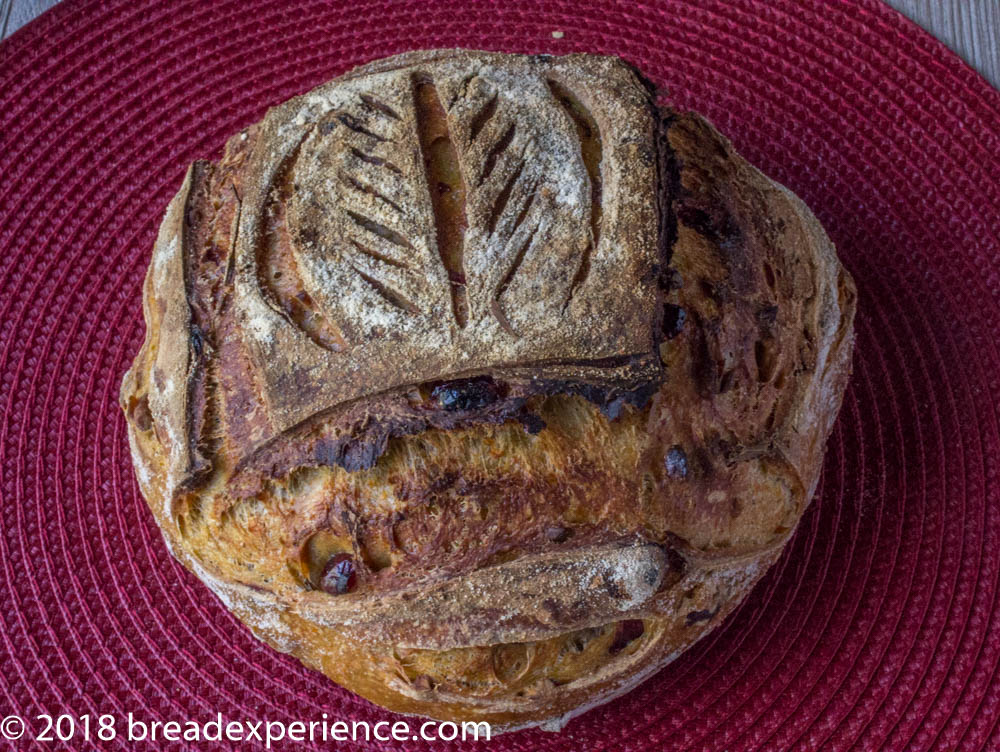
Sourdough Sweet Potato Crunch Bread with Emmer, Spelt, Pecans & dried Cranberries
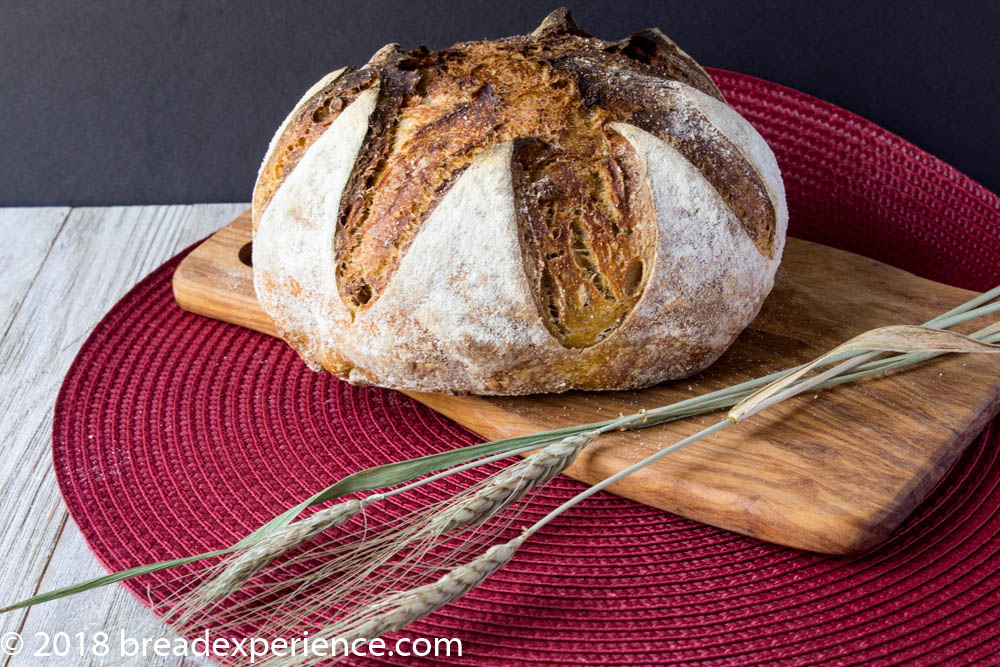
Sourdough Sweet Potato Crunch Bread with Emmer, Spelt & Pecans
Happy Baking!
Cathy
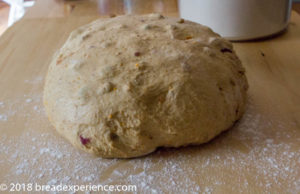
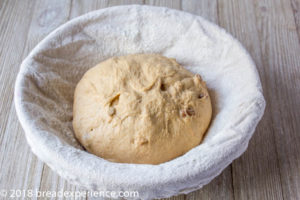
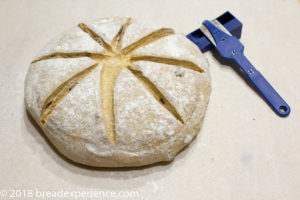
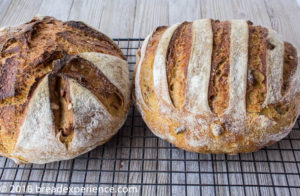

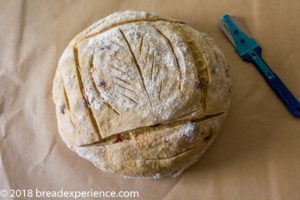
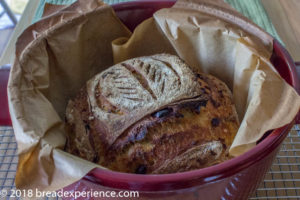
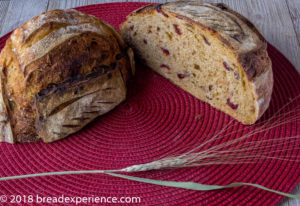
Dena says
Either I missed it in the instructions but I don’t see a baking time?? Do I remove the Dutch oven lid to help crisp the crust??
Cathy says
Hi Dena,
Thank you for catching that. I must’ve edited that part out when I added some additional instructions. The total baking time should be 40 minutes. 25 minutes with the lid on and 15 with the lid off. I have updated the recipe accordingly. Sorry for any confusion.
Happy Baking!
Cathy
brec says
I’m just beginning, so this is a very elementary question! How do I get from the raw whole sweet potatoes that I bring home from the store to the roasted sweet potatoes in the ingredients list?
Cathy says
Thank you for bringing this to my attention. It is not an elementary question at all. I have added the following process to the instructions.
Preheat oven to 375 degrees F. Wash and peel sweet potato and cut into chunks. Place in a roasting pan and drizzle with olive oil. Roast until the potato chunks are soft enough to mash. You can cover with aluminum foil if it starts to get too crunchy on the outside before it is soft on the inside. You can also leave the peel on if you prefer, but I didn’t for this recipe. Cool slightly and mash with a potato masher.
Let me know if you have any further questions.
Happy Baking!
Cathy
brec says
Thanks!
(1) Could I avoid the oil by “baking” them (or it) whole in a microwave in a plastic steam bag, then mashing? I “bake” white/Russet potatoes that way. If I did that I’d have to scoop/scrape out the contents of the skin/peel, then decide what to do with the skin/peel. Eat it — I like ’em — or chop and include in the dough.
(2) “15 grams (3 tsp) salt + 25 grams add’l water, if needed” Why the note there about the possible need for more water? Is it related to the salt? There’s also, “300-325 grams water + more if needed.”
I’m some ways off from knowing when more water is needed — I just baked my first oven loaf yesterday, after using the dough course of my bread machine — but this specific recipe is now one of my goals!
Cathy says
You can roast the sweet potatoes however you prefer.
I edited the recipe yesterday after making the bread again this weekend. The note about adding additional water with the salt was for hand mixing. However, since I recommend using a mixer to mix this dough, you can ignore that note. I edited it out of the recipe.
As for the hydration level, it depends on the type of flour you are using. When I made the bread this weekend, I needed to use more water due to the coarseness of the home-milled spelt flour. I updated the recipe to say 325 grams – 400 grams of water. If your whole grain flour is not as coarse, you may not need as much water. Add it gradually while mixing the dough; otherwise, you may end up with sticky and too wet dough.
Thank you for all of your great questions!
brec says
“Bread flour” — King Arthur Flour says that their Bread Flour, at 12.7% protein, has 1% more protein than other brands of bread flour. So, I reason, KA All-Purpose, at 11.7% protein, which I have on hand, should be like most brands of bread flour. Do you think the KA All-Purpose would be an OK substitution?
I’m ordering Emmer flour. I’m hoping this will all come together next week!
Cathy says
Yes, KAF all-purpose will work perfectly in this bread. That’s typically what I use as well. I will note this in the list of ingredients.
brec says
“Sweet potatoes”?
I shop at both a chain supermarket and at a Sprouts Farmers Market. At the supermarket, all the yams are called “sweet potatoes.” At Sprouts, they’re labeled as various varieties of “yam”, and only a light, not-red not-purple potato, which I know from experience has a light-color firm flesh, is labelled as a “sweet potato.”
Which do you recommend for this recipe?
Cathy says
I don’t think it would really matter which ones you used, except the color might be different. I used sweet potatoes from a supermarket chain if that helps.
brec says
After looking at some Sweet Potato Crunch recipes I think an orange-flesh variety is most likely.
Tonight is preferment night! I’m thinking of using dried blueberries rather than cranberries, just because I happen to have them on hand.
Cathy says
I always use the orange-flesh colored ones myself, but a purple one might make an interesting looking bread. I’ll have to consider that for a future bake. Dried blueberries sound good, but adding the dried fruit is optional. I made this bread a couple of times with only the pecans before I thought to add the dried cranberries. I think it’s a delicious bread with or without the dried fruit. Happy Baking!
brec says
After 10 1/2 hours at room temperature in a cloth-covered bowl, the pate fermentee has developed a fairly robust surface skin. I’m wondering it this is expected.
Cathy says
I would expect this preferment to be similar to the consistency of dough. For prefements that require a longer fermentation, you can cover the bowl with plastic wrap, a plate, or lid to prevent a surface skin from developing.
Steve Brecher says
For some (almost) real-time reporting of difficulties, please see:
http://www.thefreshloaf.com/node/58348/uh-oh-beginning-swimmer-deep-water
Steve Brecher says
The first loaf acquired an asymmetric shape during baking, but is delicious nonetheless. The second loaf, which I proofed partially in the refrigerator, came out of the oven looking fine — it’s still cooling as I write this.
Here’s a pic of the second loaf:
https://www.thefreshloaf.com//files/u147432/Sweet%20Potato%20Crunch%202nd%20loaf.jpg
Cathy says
Steve,
Thank you for sharing your experience with this bread. I’m glad the first loaf was delicious even if the shape was a little off. I find that once you slice it, it doesn’t matter. Your second loaf looks great!
In the other thread, you mentioned that you used lava rocks under your baking stone for the 2nd loaf. I haven’t tried that method, but it seems to have worked well for your loaf. Very cool!
Now that you’ve made this bread, if you have any tips, suggestions, or clarifications, please let me know.
Happy Baking!
Cathy
Cindy Falk says
Cathy,
Beautiful breads! We would like to invite you to enter the 2019 National Festival of Breads: Americas Bread Baking Championship in the Food Blogger Division. Entries are due on January 1, 2019. For more information visit: http://www.nationalfestivalofbreads.com
Cathy says
Thanks for sharing Cindy!
Rebecca says
Lovely bread! Followed the recipe but used walnuts instead. Easy to make and planning on making it soon again.
Cathy says
Wonderful! So glad you liked it! Walnuts are a great add. This is a family favorite.